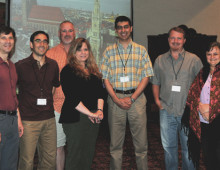WALNUT CREEK, CA—Among the many changes in the ocean is the expansion of oxygen-deficient or oxygen minimum zones (OMZs), also known as dead zones, which affect the processes by which carbon is captured and sequestered on the seafloor and alter the microbial activities that impact the rate and magnitude of ocean carbon sequestration. Despite the…
JGI’s Fall 2009 Primer now available for download
Featuring, in no particular order: JGI’s new Fungal Genome Program and GEF project differentiating between oligotrophs and copiotrophs Lessons from the Genomics Standards Consortium’s 8th meeting held at the JGI in September, and useful acronyms for parsing their pages Gap Resolution software T. reesei (redux) Nectria‘s extra chromosomes JGI collaborators and their projects at HudsonAlpha,…
Jonathan Eisen on Fora.tv
Video of Jonathan Eisen, head of the DOE JGI’s Phylogenomics Group, talking about “The Evolution of Microbes and their Genomes” at the California Academy of Sciences on October 3 now on Fora.tv
Genome Project Standards paper covered by GenomeWeb
With sequencing speed increasing and cost decreasing, some have estimated that public databases will house 12,000 draft genomes by 2012. But because the quality and completion of these genomes varies dramatically, the authors suggest new standards are needed to classify draft and finished genomes — and everything in between. “Exponential leaps in raw sequencing capability…
“Establishing standard definitions for genome sequences” on Science Codex
As the proverbial “fire hose of data” becomes a Niagara torrent, with conservative estimates of 12,000 draft genomes hitting the public databases by 2012, researchers may be surprised to find that these datasets describe genomes that are not complete. Recognizing the problem, a group of researchers from several sequencing centers, including the DOE Joint Genome…
“Joint Announcement sets Six Genome Sequence Standards”
“Standards are a major issue to be tackled in genomics right now,” says Patrick Chain from Los Alamos National Laboratory (LANL), New Mexico, USA and joint first author. “These proposals are guideposts meant to inform users and generators.” A range of next-generation sequencing technologies, increasingly deployed in research, generate massive amounts of data in any…
Need for standard definitions covered by PhysOrg
As the proverbial “fire hose of data” becomes a Niagara torrent, with conservative estimates of 12,000 draft genomes hitting the public databases by 2012, researchers may be surprised to find that these datasets describe genomes that are not complete. Recognizing the problem, a group of researchers from several sequencing centers, including the DOE Joint Genome…
“Geneticists call for better draft sequences”
Researchers who have mapped a species’ genome need to be more explicit about the quality of their sequence, says an international team of genome researchers. “People generating these sequences should discriminate a bit more between the products that they provide to the rest of the scientific community,” says Patrick Chain of the Joint Genome Institute…
Standard definitions for genome sequences on EurekAlert!
In 1996, researchers from major genome sequencing centers around the world convened on the island of Bermuda and defined a finished genome as a gapless sequence with a nucleotide error rate of one or less in 10,000 bases. This effectively set the quality target for the human genome effort and was quickly applied to other…
Establishing Standard Definitions for Genome Sequences
WALNUT CREEK, CA—In 1996, researchers from major genome sequencing centers around the world convened on the island of Bermuda and defined a finished genome as a gapless sequence with a nucleotide error rate of one or less in 10,000 bases. This effectively set the quality target for the human genome effort and was quickly applied…

